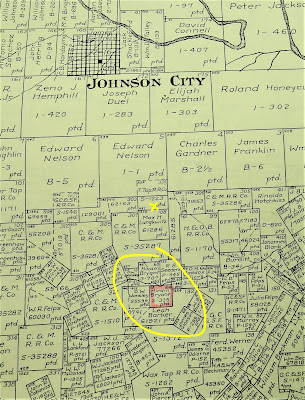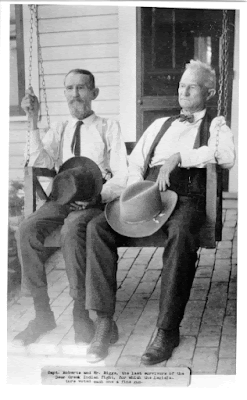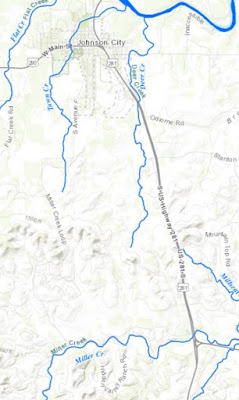The Deer Creek Fight
After deeper historical research, it is the intent of this article to fix the location of the Deer Creek Fight squarely in the center of Blanco County. It is not the intent of this article to re-write the history of that event, which has been better recorded by numerous other sources.
Following Comanche raids in the Texas Hill Country in the late 1860’s, especially the killings of Thomas and Eliza Felps (spelled Phelps in some write-ups) on Cypress Creek a few miles from Round Mountain in late July 1869, the outraged settlers of Blanco County petitioned the Texas State government for more protection. In 1871 the State Legislature finally authorized the formation of “Minute Men” militia companies for the frontier defense. Company A was organized in Blanco County under the command of Lieutenant James Ingram.[4]
In August 1872, a band of roving Comanches was spotted near Porter Gap (in northwestern Blanco County about ten miles due west of Round Mountain) by future Texas Ranger Captain Daniel Webster Roberts. He and five others from the Round Mountain community followed the trail south along Hickory Creek. They were joined by Lt. Ingram and three other local men and tracked the Native Americans to a location southeast of what is today Johnson City to the headwaters of Deer Creek, just north of the foothills of today’s Mountain Top.
Lt. Ingram’s account of the resulting skirmish follows:
The Indians have been in, and again the Round Mountain boys have met and fought them, but not with the usual result. The following named boys, to wit, J.T. Bird, J.D. Bird, D. W. Roberts, George T. Roberts, W. E. Ingram, James Ingram, John Biggs, F. S. Waldrope and J. C. Davidson struck the Indian trail at what is known here as the Porter Gap, and followed the trail about sixteen miles and came upon the Indians on the head of Deer Creek, near the Austin and Fredericksburg road, not far from Hiram Bryant's place. The Indians had stopped and tied up their horses in a cove of the mountains where they could have a natural fortification from all sides, and were barbecuing meat, as they had killed four beeve on the trail. When in about one mile we discovered the spies coming off the mountains and charged them. When we got up in about sixty yeards [sic] the Indians fired a volley of about twenty or twenty-five guns at us, and wounded Mr. George T. Roberts through the nose with a Winchester ball. They were well armed with Winchester rifles. We then dismounted and began fighting in hard earnest for it began to look like business. After fighting about twenty minutes in that way, Mr. D. W. Roberts was wounded through the thigh and J. D. Bird slightly in the shoulder. Mr. J. D. Bird and F. S. Waldrope's horses were both wounded. Twelve Indians left us to cut us off from the wounded; and we were forced to leave the Indians, as we had charged them over a bald prairie and were fighting on the prairie on the side of the mountain without any protection. The Indians were in front of us in the cove and twelve on the mountain to the left. We were thus compelled to retreat. We killed two Indians that we are pretty certain of (though could not get them as the Indians carried them off) and two horses. The Indians numbered between twenty-five and thirty-five, with as good a fort as they could desire, and we had to charge and fight them from the open prairie. Since an examination of the ground, it is agreed, by the most of old Indian fighters, that forty men could not have driven them out of the fort….[5] [italics added]
Ingram’s identification of the “Austin and Fredericksburg Road” and “Hiram Bryant’s place” in his report further localizes the Deer Creek Fight to the center of Blanco County. The Hiram Bryant land grant is located about three miles due south of the headwaters of Deer Creek, and the Austin-Fredericksburg road described in Ingram’s account, one of three routes at the time from the Capital City to the Fredericksburg German settlement, ran east to west in the same vicinity, following the course of Miller’s Creek.
Dan W. Roberts’ account of the battle further specifies the location of the fray:
“My wound was bleeding so freely and I was suffering so much for water that the boys realized that they must get me away quickly. We found water within a mile of the scene of the fight, and from there I was carried to Johnson’s ranch, about two miles further on….After carrying George and myself to Johnson’s ranch where we could have attention, one of the boys rode over and reported the fight to Captain Rufe Perry, who lived half a mile away….[6] [italics added]
“Johnson’s Ranch” would have been the Johnson Settlement, homestead of James, Thomas, and Sam Ealy Johnson, Sr. Sam Ealy Johnson was the grandfather of future President Lyndon B. Johnson. Cicero Rufus Perry, veteran Texas Ranger, was a resident of Blanco County as early as 1860.
Even while Dan Roberts’s fading memory would not recall the exact date of the fight, he would confirm the location when he visited Blanco County in 1925, 52 years after the incident. He stated that the area was “unchanged” except for the Austin-Fredericksburg road, which now ran through the “center of the field.”[7]
A newspaper account from the Austin American Statesman of April 12, 1936 further confirms the location of the battlefield: “From the top of Big Mountain, 3 ½ miles southeast of Johnson City, a commanding view may be had of the valley where the famous Deer creek fight took place in August, 1873” [sic]. And, “one fourth mile off Highway 20 [today’s U.S. Highway 290—author], in Johnson City, is the historic Johnson home, for which Johnson City is named….The men who were wounded at the Deer creek fight were cared for there.”[8]
The current Austin-Fredericksburg road, today’s U.S. 281/290, encompasses the highway pass between Big Mountain, on the east side of the highway, and Lone Man Mountain, on the west side of the same highway. The reference name given to those peaks in the 1930’s are today collectively referred to as Mountain Top.
Given the information cited by the sources above, the location of the Deer Creek Fight can be placed with certainty in the area between the headwaters of Deer Creek and US Highway 281, south of Stanton Ranch Road, and about three miles south-east of downtown Johnson City, on the north side of Mountain Top. The location is on private property and is not available for visitation.
Photos
 |
| Rufus Perry Gravesite, Masonic Cemetery, Johnson City |
 | ||
| Rufus Perry Cabin in Johnson City |
 |
| The restored Johnson Settlement ranch house in Johnson City |
 |
| Felps' tombstone inside the Miller Creek Cemetery |
Maps
 |
| Hiram Bryant land grant. X marks the headwaters of Deer Creek. |
About the Author
Steve Rossignol is a retired member of IBEW Local 520 in Austin, Texas, and a member of the Blanco County Historical Commission.Footnotes, References
[1] The raiders were presumably Comanche. Dan W. Roberts identifies them as “Indians,” but in later accounts of different skirmishes in the Hill Country (such as the Pack Saddle Mountain fight) he specifies the Native Americans as Comanche. Given the historical time frame and the geographical location, and based on separate identification of the other raids as Comanche, it will be assumed that the participants in the Deer Creek Fight were Comanche.[2] Mike Cox, “Burnet County: Deer Creek,” Gunfights and Sites in Texas Ranger History, The History Press (Charleston, South Carolina), 2015, p. 64.
[3] Bob Alexander, Winchester Warriors: Texas Rangers of Company D, 1874-1901, University of North Texas Press (Denton, Texas), 2009, p. 10.
[4] Glenn Hadeler, “Into the Past with Capt. Perry,” Johnson City Free Press (Johnson City, Texas), March 21, 2001, p.5.
[5] James Ingram, Round Mountain, Texas, “Correspondence to the Editor,” Tri-Weekly State Gazette (Austin, Texas), August 23, 1872, p.2.
[6] Dan W. Roberts, “The Deer Creek Fight,” Rangers and Sovereignty, Wood Printing and Engraving Company (San Antonio, Texas), 1914, p. 25. (Kessenger Publishing Legacy Reprint).
[7] Arthur E. Nall, “Old Rangers Visit Scene of Conflict,” Houston Chronicle (Houston, Texas), July 26, 1925, (also in Austin American (Austin, Texas), June 14, 1925); reprinted in Frontier Times, September 1925, p. 33.
[8] “When Grandpa Fought the Indians,” Austin American (Austin, Texas), April 12, 1936, p. 14.



No comments:
Post a Comment